|
In
my collections of conus I have quite a few "freak" specimens.
I consider freak specimens to be those with characteristics that are
not comparable with typical specimens. This could be in the form of
a strange new pattern or color, as well as obvious growth defects
both natural and/or with man-made aspects ( like pollution ). In terms
of pattern or color, I dont think a shell should be specifically labeled
a freak, unless the pattern is due to a growth flaw or other defect.
For example...... this picture of a beautiful large 115mm Conus
marmoreus has a particularly beautiful and odd pattern, but I
would not call it a freak! I think of this as more of a color/pattern
variant rather than a freak pattern.
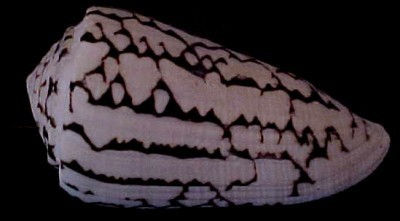
Here is a lovely group of odd conus, all with a turreted or "stepped"
spire.....a growth defect that is not terribly uncommon among different
species. As pictured left to right, Conus bandanus 103mm, Conus
imperialis 96mm, Conus miles 98mm, and Conus caracteristicus
52mm.
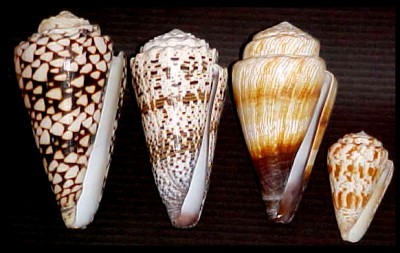
Sometimes a growth defect is limited to an area.....for example in
this pair of conus, a bite or other anomaly has caused a sharp keel
in the shoulder , which resemble a hump or several humps. From left
to right......Conus litteratus 105mm, and Conus flavidus
42mm. ( picture is labeled mvc017s.jpg).
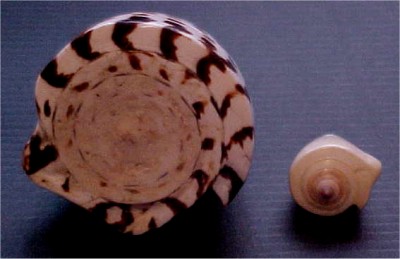
Here is a lovely grouping of freak Conus janus, in sizes ranging
from 45mm to just over 65mm. The specimen on the top has a badly injured
shoulder, giving it a tremendously large humpback. The specimen on
the far left with the exquisite pattern has a very widely flaring
lip. The next specimen over had a stepped body whorl and I placed
the shell so it can be seen. The next specimen has a very large humpback,
and the specimen on the far right has a very nicely shaped turreted
spire. All of these shells are very beautiful to me. These were collected
in Madagascar.
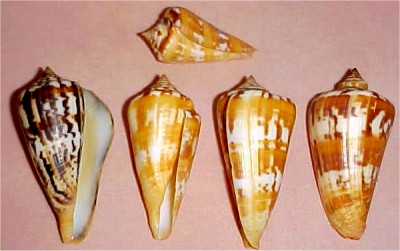
Here is another wonderful trio of freak cones......a splendid Conus
textile forma concatenatus, 64mm, collected in Madagascar.
It has a flagrant bite or anomaly on the dorsum by the shoulder, which
not only distorts the shell but created a very fine small wing like
projection. A rather interesting piece. Below this to the left, is
a spectacular shell within a shell, so to speak. A Conus inscriptus,
49mm, fished off of India. This piece is very heavily turreted, giving
the appearance of another inscriptus growing inside the bigger inscriptus.
A very handsome specimen!! To the far right, is a grossly turreted
Conus ebraeus, with a superior thick turret spire growth. I
was very pleasently surprised to see this specimen arrive to me, and
it was collected in the Philippines.....it measures 28mm and also
has the appearance of a shell growing out of another shell.
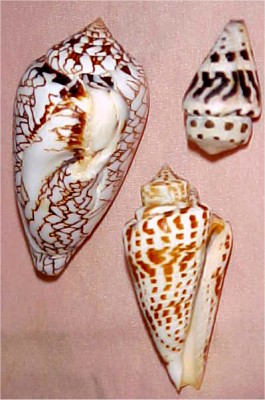
Also from the Philippines, a lovely Conus virgo 107mm, with
a bizarre "canal" running along the entire first whorl,,,,,forming
a deep interior suture. This canal also has no color, while the rest
of the shell is a deep yellow-pink. It gives the appearance of a mushroom
type shoulder. This is also a very beautiful specimen.
(unfortunately is light due to color of shell ).
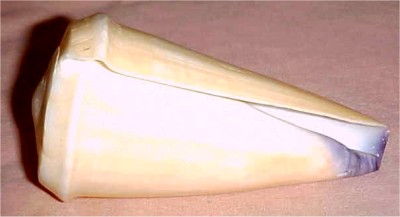
Here
are some examples of extreme freaks.....this is a grouping of fantastic
Conus betulinus I received from Madagascar last year. They
range in size from 46mm to 60mm. The top specimen is very bulbous,
and although you probably cannot see how so from the picture the bottom
half of the whorl is quite slender while the top of the whorl by the
shoulder is inflated. It looks like a small pear. The specimens below
this are all extreme injury freaks, with the most bizarre one being
the specimen on the far right, which not only is flattened, but also
has two large "varices" formed from the whorl, which you
can see has overlapped both the lip and the outer shoulder. If you
look closely inside the aperature you can see the beginnings of a
"second shell" growing from within. This extra area would
be similiar to our own scars, where the area raises itself and produces
extra material. They are all very fascinating!!!
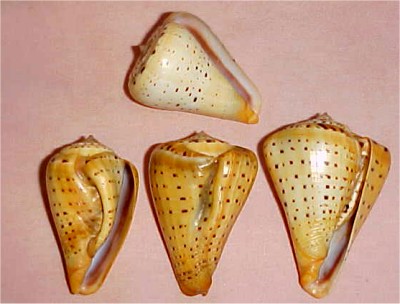
The next picture is of the same shells but a top view to show the
extent of the damage to these Conus betulinus and how they
have grown around the injuries. Fascinating!
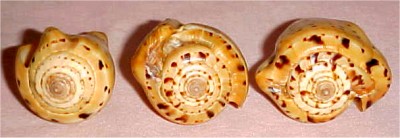
My last grouping of the day contain some rather mild freaks....specimens
which are "tilted" or grow on a mild curve such the wonderful
Conus terebra 49.8mm to the far left, beside that specimen
is a Conus tribblei 52.5mm which also grew on a slight curve.
On the far right is an extreme injury freak Conus tribblei
26.5mm, in which the injury has caused the siphonal canal area to
completely grow around it's own self. I suspect the snail had no problem
siphoning water though , as the opening is much bigger than it would
have normally been ! At the top of the picture to the right is a wonderful
Conus litteratus specimen which has been seemingly sliced in
half!! This anomaly was most likely caused by something stuck in the
mantle perhaps a grain of sand ( ?), as the slit does not go completely
around the body whorl. It is a rather unique specimen and it measures
61mm. It also has the nice yellow banding which! makes this specimen
even more prettier. All of these specimens were collected in the Philippines.
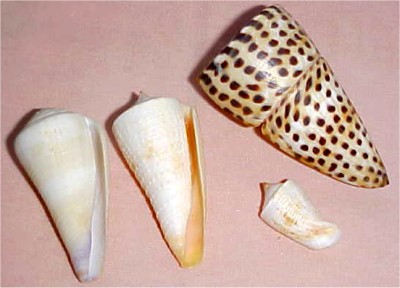
Lyle Therriault
lookinhereyes@earthlink.net
|



